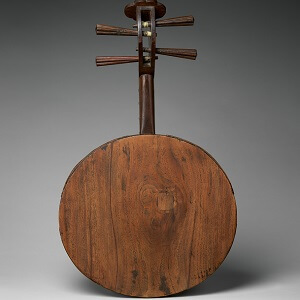Gekkin
 It is a plucked string instrument of the lute family and has a round sound box and a short neck. The number of strings differ depending on the period and country and it has typically two to four strings and, in the case of four strings, two courses of paired strings are strung. For strings, silk yarn was used in the past and wire was also used later and, at present, nylon steel yarn is the main stream. Tuning method also differs depending on the period and country.
It is a plucked string instrument of the lute family and has a round sound box and a short neck. The number of strings differ depending on the period and country and it has typically two to four strings and, in the case of four strings, two courses of paired strings are strung. For strings, silk yarn was used in the past and wire was also used later and, at present, nylon steel yarn is the main stream. Tuning method also differs depending on the period and country.
Pressing the strings ten to twenty-four frets with finger, and the string is picked to make sound. It has no hole for resonance. When playing, the player sits on a chair and places the gekkin on the thigh and play keeping the sound chamber a little away from the player. Some gekkin are provided with a mechanism called narido in the sound chamber; in the narido, unstable metal parts are equipped and sound is made by swinging or hitting it.
The Yi, a minority race, play a gekkin with a hexagonal sound chamber and a gekkin with a long neck. Gekkin is used for Ming and Xing-era Chinese music (popularized in Japan before the First Sino-Japanese war) in Japan. While a gekkin used for Ming-era Chinese music is "ruanxian" (4 or 5-stringed Chinese lute) with a long neck, the "gekkin" used for Xing-era Chinese music is one with a round sound chamber. These two instruments are completely different from each other.